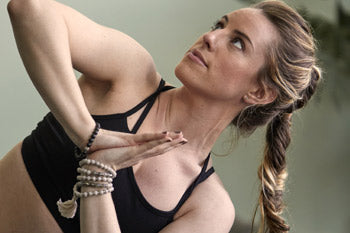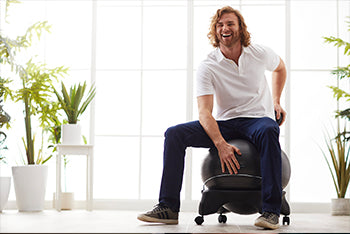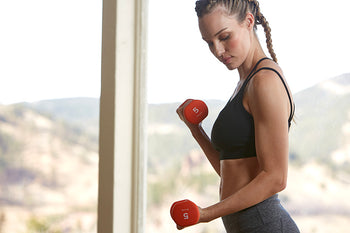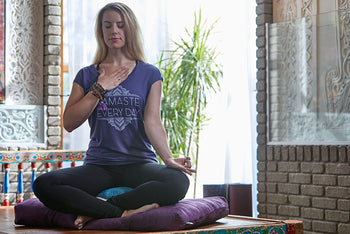Can Yoga Replace Weight Training?

by Kelly Turner, ACE certified personal trainer
Experts advise doing some form of strength training at least twice a week to keep the metabolism running efficiently, and many doctors recommend weight training as the number-one preventive measure against bone loss.
For many of us, this conjures a vision of becoming an eternal slave to weight machines, dumbbells, or resistance cords. So...can you just do some yoga instead?
Can yoga really build muscle?
“People always ask me, ‘Don’t you lift weights?’” says yoga expert Rodney Yee. “I sort of giggle to myself and say, ‘Yes — I lift my own body weight!’”
When you do yoga poses, Yee explains, “You’re putting your body in positions and orientations that you ultimately have to support with your muscles. So you are lifting weights.”
Like many yogis, Yee doesn’t like focusing on how yoga can sculpt your physique. They want students to focus on yoga as a way of thinking, feeling, and being, versus getting preoccupied with perfecting their outer appearance.
Still, when you look at Yee’s arms or those of his wife, Colleen Saidman, you can’t help but want some of the yoga poses they’re having for breakfast.
The upshot is that you can increase muscle tone and definition — and even muscle size — with yoga. But because you're limited to “lifting” your own body weight, it may take a lot more skill, time, and determination than it would with lifting weights.
“Yoga can be just as effective as weights when it comes to building a stronger, more impressive physique,” says Nicholas DiNubile, M.D. Yet experts agree that whether yoga can be your sole form of strength training depends on your goals.
Weights are best for building bulk
“If all you’re looking to do is build muscle, weight training is the more practical approach,” advises DiNubile. In fact, the American Council on Exercise defines strength training as “exercising with progressively heavier resistance for the purpose of strengthening the musculoskeletal system.”
Yet the key phrase here is progressively heavier resistance. Basically, your muscles and bones must be overloaded to keep developing. With traditional weight training, as your muscles adapt to the resistance and get stronger, that weight is no longer a challenge, and you have to add more weight to achieve the same results.
With weight training, theoretically you can continue to grow the size and strength of your muscles forever — as long as you continue to add weight.
Yoga is a more well-rounded approach
There are several reasons yoga is a more balanced way to do strength training:
- A regular yoga practice can reduce your risk of injury and condition your body to perform better at things you have to do every day: walk, sit, twist, bend, and lift groceries. A form of functional fitness, yoga moves your body in the ways it was designed to move to help ensure that it keeps functioning properly. For example, in yoga you use both large and small muscles and move in many directions (twisting, arcing, etc.), not just back and forth on a one-dimensional plane, as in the forward-back motion of a bicep curl.
- Yoga tones muscles all over your body, in balance with each other. Weight training exercises typically isolate and flex one muscle or muscle group at a time.
- Yoga relies on eccentric contraction, where the muscle stretches as it contracts, giving the muscles that sleek, elongated look while increasing flexibility in the muscles and joints. Weight training relies on the opposite physical principle of concentric muscle contraction, which means the muscle gets smaller as it contracts. Without proper stretching, the muscle fibers heal close together, giving the muscle that compact, bulging look.
- Yoga increases muscle endurance because you typically hold any given pose for a period of time and repeat it several times during a yoga workout.
For good general fitness, do some of both
I advise clients who are just trying to stay fit and healthy (not do body-building) to get a mix of both body-weight exercises and workouts using weights or resistance tools. Many studies have shown that the more variety in your workout routine, the faster you’ll see results.
Note that body-weight exercises also include good ol’ push ups, squats and other calisthenics — any type of movement that requires you to hold or lift yourself up with your limbs.
While the most important thing is to find a form of exercise you love and can see yourself doing as a lifelong habit, I encourage my clients to continually try new and different forms of exercise. If you include many types of workout techniques, you’ll continue to test and push your body in different ways, and you'll keep growing as a fitness enthusiast and as an individual.
Which yoga poses are best for developing strength?
Yee explains that certain types of yoga poses build muscle tone in different ways.
“Challenging arm balances and inversion poses are very effective for building muscle strength,” he says, “because they flex groups of smaller muscles — not just the major muscles you work with a weight machine — to support the body’s weight during the pose.”
“Holding standing poses such as the Warrior Poses and Triangle Pose is great for strengthening the leg muscles,” he adds. “And in balance poses such as Tree Pose, one leg has to hold up your entire body, so you’re increasing your strength just by putting your weight on that leg.”
By holding the positions longer, doing more repetitions, and learning new yoga poses, you can make your yoga practice more or less challenging, just as you can with traditional bodyweight exercises like squats and lunges. Just don’t try to go straight to the advanced yoga videos and poses like arm balances to get on a fast-track to “cut” arms. Start with basic yoga poses at a class or using a yoga DVD.
Also in Blog

Body Peace & Personal Empowerment

Yoga for Swimmers: Poses for Strength and Mobility







